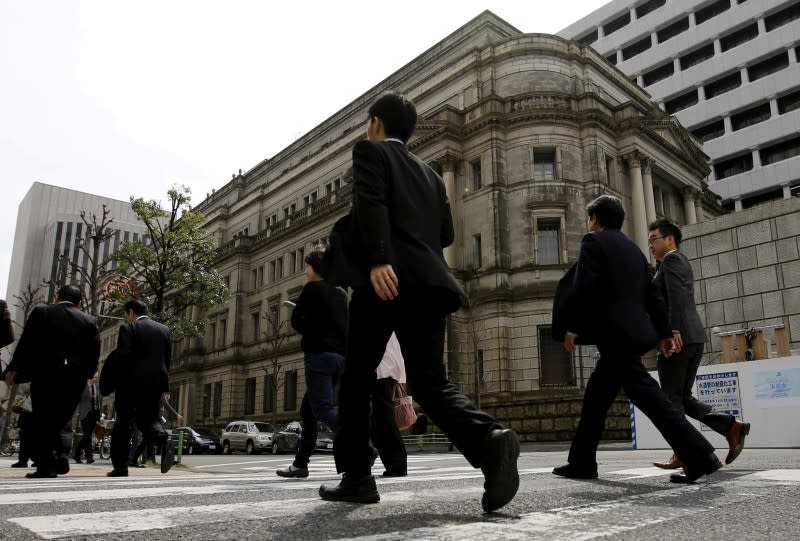Exclusive: Under govt pressure, BOJ mulling specific steps for easing - sources

By Leika Kihara and Minami Funakoshi
TOKYO (Reuters) - The Bank of Japan, under pressure from the government, is considering specific steps for expanding monetary stimulus on Friday to address signs of weakness in inflation, people familiar with the central bank's thinking said.
By timing its action with the government's big fiscal spending package, the bank would aim to maximise the boost of its measures on the world's third-biggest economy, which is struggling to escape decades of deflation, the sources said.
The Ministry of Finance is lobbying hard for the BOJ to ease policy further and has prepared a statement it will publish in the event that the BOJ eases.
"We welcome the BOJ's decision and will deploy all necessary policy steps including a scheduled big stimulus package," says a draft statement seen by Reuters.
It is uncertain whether the MOF has drafted the statement because there is a high chance the BOJ will ease policy or only because it is standard practice to prepare one as a precaution in case the central bank shifts policy.
But the fact a draft statement is being prepared suggests the government is keen for the BOJ to ease on Friday.
Some board members may dissent to BOJ Governor Haruhiko Kuroda's proposal for easing due to wariness over the rising costs and diminishing returns of an already massive stimulus programme, however.
The dollar gained to a U.S. session high of 104.98 yen (JPY=) on Thursday after the report.
BOJ IN BIND
Pressure for BOJ action intensified with Japan's economy minister calling on the bank to work with the government to spur growth in the wake of Prime Minister Shinzo Abe's announcement of a bigger-than-expected 28 trillion yen ($266 billion) stimulus package on Wednesday.
Worried about their dwindling policy options, many BOJ officials prefer to not ease now. Some have openly voiced doubts over the feasibility of expanding an already massive stimulus programme that has failed to boost inflation.
But analysts say the BOJ has little choice but to ease, with markets almost fully pricing in action and Abe having put the ball into the bank's court by unveiling his big spending plan days before its policy meeting.
"Abe's announcement is a squeeze play on the BOJ. The BOJ has to move now. It is unavoidable," said Hiroaki Muto, an economist at Tokai Tokyo Research Centre.
Even if the BOJ were to act, it is unlikely to please market players betting on radical steps such as "helicopter money," or direct central bank underwriting of public debt.
That means the BOJ will likely use its existing policy framework that combines negative interest rates with the huge asset-buying programme adopted in 2013.
The BOJ is now buying roughly 110 to 120 trillion yen of government bonds a year to meet a pledge to expand the total amount of its JGB holdings at an annual pace of 80 trillion yen.
Expanding bond purchases further would be a challenge as the BOJ already holds one-third of Japan's entire government bond market.
Still, a sizable increase in bond purchases, combined with an expansion of risky assets like exchange-traded funds (ETF), would be the most likely option if the BOJ wants to shock markets by scale, the sources say.
The option of deepening negative rates from the current minus 0.1 percent is less preferred, as the policy, decided on January, has proven unpopular among the public, they say.
Some analysts aren't quite sure what could happen given Kuroda's history of springing surprises.
The BOJ will take into account the boost to growth from Abe's stimulus package, which means any cut to its inflation forecasts will be small, sources have told Reuters. That makes it hard for the bank to justify acting now.
"It's like trying to read Kuroda's mind - to be honest, we can't say we're very confident (about our predictions) and I think other analysts are the same," said BNP Paribas economist Hiroshi Shiraishi, who sees a 60 percent chance of easing.
"Unless the BOJ does something really big, it can't go above the already high expectations. But if it does do something really big, there's a chance the side-effects and future costs will be really big."
($1 = 104.7700 yen)
(Additional reporting by Takaya Yamaguchi and Sumio Ito; Editing by William Mallard and James Dalgleish)

 Yahoo Finance
Yahoo Finance 